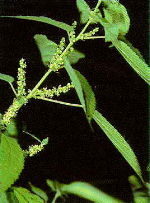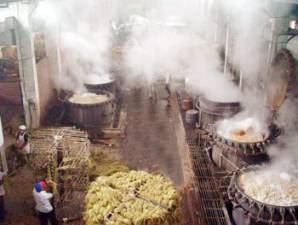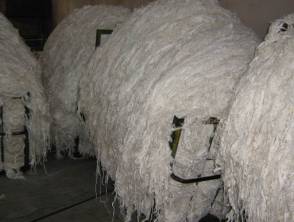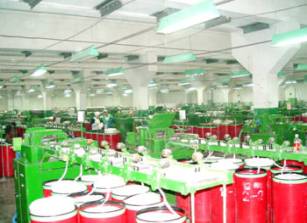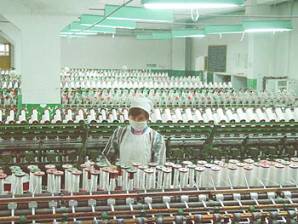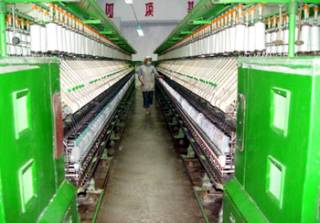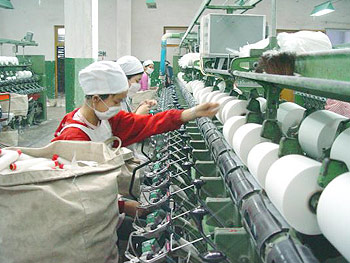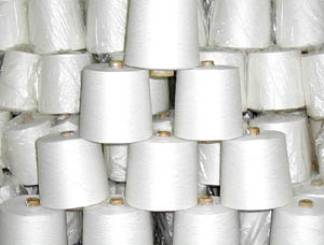

|
|

Ramie

Ramie yarns
Introduction
Ramie (Boehmeria nivea),
commonly
known as China grass, white ramie, green ramie and rhea, is one of the
group referred to as the bast fiber
crops. It is a hardy perennial belonging to
the Urticaceae or Nettle family, which can be harvested up to 6 times a year. It
produces a large number of unbranched stems from underground rhizomes and has a
crop life from 6 to 20 years. The bark contains gums and pectins causing the fibers to be useable only after chemical treatment.
The true ramie or ‘China Grass' is also known as ‘white ramie' and is the
Chinese cultivated plant. It has large heart shaped, crenate leaves covered on
the underside with white hairs that give it a silvery appearance. Boehmeria
nivea var. tenacissima, is known as ‘green ramie' or ‘rhea'. It is believed
to have originated
in the Malay Peninsula. It has smaller leaves which are green
on the underside, and is better suited to tropical climates.
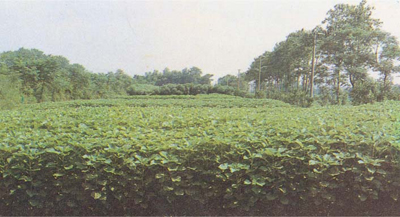
Ramie is one of the oldest textile fibers. It was used in mummy cloths in
Egypt during the period 5000 - 3000 BC, and has been grown in China for many
centuries. The main producers of ramie today are China, Brazil, Philippines,
India, South Korea and Thailand. Only a small percentage of the ramie produced
is available on the international market. Japan, Germany, France and the UK are
the main importers, the remaining supply is used domestically (in the country in
which it is produced).
Ramie fiber
is very
durable, is pure white in colour and has a silky luster. It is reported to have
a tensile strength eight times that of cotton and seven times greater than silk.
However, other reports claim that the tensile strengths of cotton, flax, hemp
and ramie are similar. These discrepancies can be partly attributed to the
effects of source of supply, method of processing, the test conditions,
temperature and humidity, on the fiber
strength.
The stems of ramie grow to a height of 1 - 2.5 meters.
The most suitable climate for ramie is one which is warm and humid, with an
annual rainfall of at least 1000 mm.
Well established plants
can tolerate drought and frost, but grow better without. As ramie productivity
is high it can rapidly deplete the soil of nutrients.
Properties
Advantages of Ramie as a Fabric
- Resistant to bacteria, mildew,
alkalis, rotting, light,
insect attack
Extremely absorbent
and therefore comfortable to wear, especially during warm
weather
Has natural stain resisting ability with ease of stain/soil
removal similar to that of linen (and this is better than cotton)
Not harmed by
mild acids
Dyes fairly easily
Good wet-fastness
in laundering - though dark colors may lose their vibrancy over repeated
launderings
Increases in strength when wet
Withstands high water temperatures during laundering
Smooth lustrous appearance improves with washing
Keeps its shape and does not shrink
Can be bleached
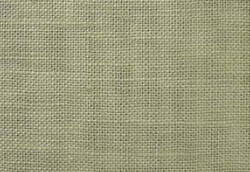
Disadvantages of Ramie as a Fabric
- Low in elasticity
- Low abrasion resistance
- Wrinkles easily
(but application of wrinkle-resistant finishes or blending with synthetic fibers can
reduce the problem in woven fabrics)
Stiff and brittle
The
fiber
is high cost which reduces its competitiveness against other
textile
fibers
- this high cost is due to high
labor requirement for production, harvesting
and decortication
There is a need to
de-gum the
fiber
prior to processing
Applications
- Apparel
dresses, suits, skirts, jackets, pants, blouses, shirts,
children wear, mixed with cotton in knitted sweaters
- Home Fashion
curtains, draperies, upholstery, bedspreads, table linens,
sheets, dish towels
- Sewing threads
- Handkerchiefs
- Parachute fabrics
- Woven fire hoses
- Narrow weaving
- Canvas
- Filter cloth
- When used in a mixture with wool, shrinkage is reported to be greatly
reduced when compared with pure wool.
- Short waste fibers are used for the
production of high quality papers, such as bank notes & cigarette papers.
- As ramie takes up phosphorous, it is potentially useful for cleaning up
the Everglades. This region suffers
from a nutrient overload from the sugar industry.
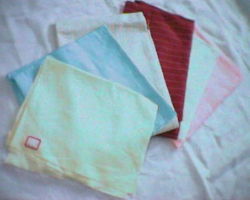
Ramie as a Blend
Ramie is most often blended (common is 55% ramie/45% cotton) with other fibers for its unique
strength and
absorbency, luster and dye-affinity. When blended with high-quality cotton it
offers increased luster, strength and color. When mixed with wool, ramie adds
lightness and minimizes shrinkage. When blended with rayon, it offsets the low
wet strength.
Care Recommendations for Ramie Fabrics
Care procedures prescribed on the care labels of ramie products vary. Items
of 100 percent ramie should not require special care. Generally, they may be
laundered or dry -cleaned depending on individual dyes, finishes and design
applications. High temperatures will not harm the fiber itself, making washing
in hot water and ironing at high settings possible; however, color retention,
shrinkage control or properties of blended fibers may dictate lower
temperatures. Recent laboratory testing done has
led to the conclusion that the best performance results when gentler or more
special handling is used in care. For example, fabrics retained the best color
and shape with the most wrinkle-free appearance when they were dry-cleaned.
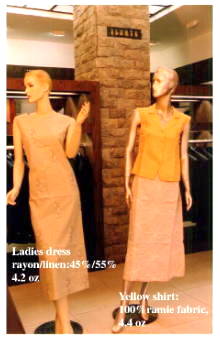

Machine washing in cold water on gentle cycle with line drying was better
than machine washing in warm water with tumble drying on permanent press cool
down cycle. Hand washing in cool water with flat drying is the most strongly
recommended home care method for both knits and woven fabrics. The consumer who knows the strengths and
limitations of the fiber can receive maximum service and enjoyment from ramie
products.
When storing ramie or ramie blends, lay them flat. Ramie fibers are brittle
and tend to break. Avoid folding the garment or pressing sharp creases in woven
fabrics.

Ramie's role in farming systems
The following characteristics of the ramie crop would influence its
suitability in Australian farming systems:
- it is a perennial crop with a life of 6 to 20 years
- it is capable of producing high yields of biomass and if the harvesting
system involves total removal of this biomass, there would be a rapid
decline in soil fertility and
- ramie is subject to a number of pests and diseases, including nematodes.
|
| Grades
|
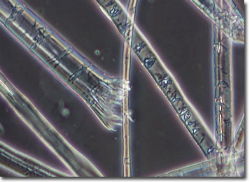
|
| Processability
The crop
Ramie is a member of the Urticaceae or nettle family and is a hardy perennial
which produces a large number of unbranched stems from underground rhizomes. The stems of ramie grow to a height of 1 to 2.5 m. The crop is generally
propagated vegetatively, using rhizome or stem cuttings. Production begins to
decline once roots become overcrowded.
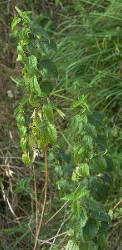
Harvesting
Ramie is normally harvested two to three times per year but under good
growing conditions can be harvested up to six times per year. Harvesting is done just before or soon after the onset of flowering, since
there is a decline in plant growth at this stage and maximum fiber content is
achieved. Stems are harvested by cutting just above the lateral roots or the stem can
be bent, to enable the core to be broken and the cortex can be stripped from the
plant in situ. Mechanical harvesters have been developed but are not used
commercially. After harvesting, stems are decorticated while the plants are fresh as the
bark gets harder to remove as the plant dries out. The bark ribbons are dried as
quickly as possible to prevent attack by bacteria or fungi.
The dry weight of harvested stem from both tropical and temperate crops
ranges from about 3.4 to 4.5 t/ha/year; a 4.5 ton crop yields about 1,600
kg/ha/year of dry non-de-gummed fiber. The weight loss during
de-gumming can be up to 25% giving a yield of de-gummed fiber of about 1,200 kg/ha/year.
Extraction of fiber
Extraction of the fiber occurs in three stages.
- Firstly, the cortex or bark is removed, either by hand or machine, in a
process called de-cortication.
- The second stage involves scraping the cortex to remove most of the outer
bark, the parenchyma in the bast layer and some of the gums and pectins.
- The third stage involves washing, drying and
de-gumming of the residual cortex
material to extract the spinnable fiber. Details of the
de-gumming processes tend to be regarded as
commercial-in-confidence information
Ramie fiber
Ramie fiber is one of the premium vegetable fibers.
The ultimate fibers are exceptionally long and are claimed to be the longest
of vegetable origin, with one report claiming the fibers range up to 580 mm,
averaging about 125 mm. Ramie fiber is very durable, is pure white in colour and has a silky
luster.
For the hand spinner, ramie is treated similar to flax in that it can be
either wet or dry spun. A wet spun yarn will produce a smooth softer yarn with
high luster, while a dry spun yarn will feel hairier, have less luster and a
harsher handle. It can readily be blended with other fibers such as wool or
silk, although the length of ramie can sometimes cause difficulties.
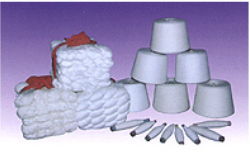
Ramie
spinning technology
|
| Background
information
History
Ramie is one of the oldest textile fibers. It was used in mummy cloths in Egypt during the period
5000-3000 BC and has
been grown in China for many centuries. Brazil began production in the late 1930s with production peaking in 1971
with about 30,000 t. Since then, production has steadily declined as a result of
competition with alternative crops, such as soybeans and the importation of
synthetic fibers. Production in the Philippines began in the early 1950s, peaking in the mid
1960s with 5,500 t. Since then, production has declined steadily.
|
| Our
supplier partner
Hunan Isunte |
|
|



